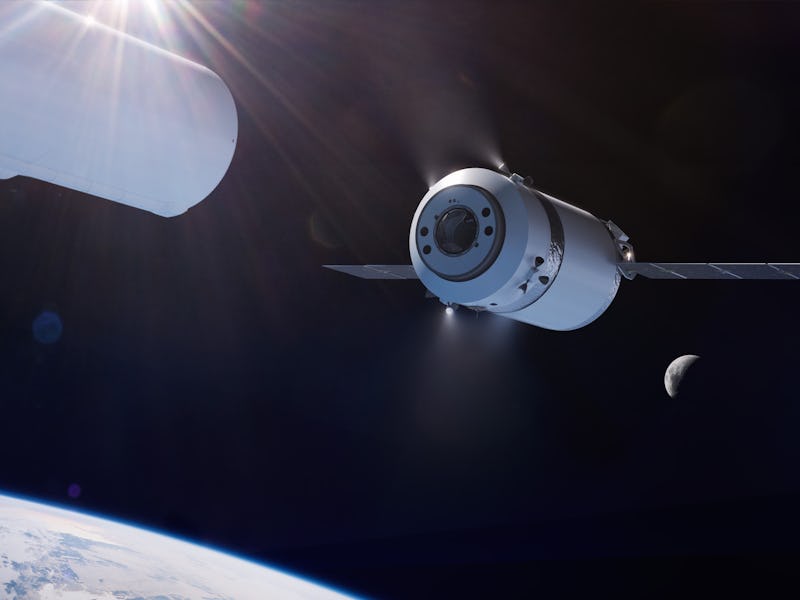Here’s SpaceX’s plan to help NASA build a moon Gateway and explore space
The company is developing an all-new capsule.

SpaceX is set to support a NASA program aimed at establishing a permanent human presence around the moon.
On March 27, NASA announced it had chosen SpaceX as the first American commercial provider to deliver supplies to the lunar Gateway. The Gateway, a small spaceship orbiting the moon, will help send humans back to the surface of the moon in 2024 as part of the Artemis project. SpaceX will use a new Dragon XL capsule to support the missions.
“This contract award is another critical piece of our plan to return to the Moon sustainably,” NASA administrator Jim Bridenstine said in a statement. “The Gateway is the cornerstone of the long-term Artemis architecture and this deep space commercial cargo capability integrates yet another American industry partner into our plans for human exploration at the Moon in preparation for a future mission to Mars.”
The agreement draws together two groups with big ideas about exploring the solar system. For SpaceX, it's working on the fully-reusable Starship rocket with a view to establishing a city on Mars by 2050. With NASA, it's working on lunar exploration and the Space Launch System rocket as springboards to fuel future missions to the red planet.
SpaceX and NASA's collaboration could help establish humanity further into space than ever before. Here's what you need to know about the plans.
What is the NASA Gateway?
The Gateway is a spaceship that will orbit the moon. It's designed to serve as both a base for lunar missions and a jumping-off point for further trips. The project includes the same partners as the International Space Station: the United States' NASA, Russia's Roscosmos, Europe's ESA, Japan's JAXA and Canada's CSA.
NASA's plans describe it as offering a series of amenities for astronauts. It will have a place to stay, a lab for experiments and docking ports. It's smaller than the International Space Station – NASA compares it to a studio apartment, versus the ISS that's about the six of a six-bedroom house – and astronauts will only stay for around three months instead of the year-long trips some do at the ISS.
NASA concept plans for the Gateway from 2018.
The first Gateway elements, featuring a power and propulsion system, are set to launch in 2022. This will enable the Gateway to start supporting missions with two people. The second phase will start after 2024, when the Artemis project is scheduled to send humans back to the surface of the moon. It's set to be fully completed by 2026.
What is the Artemis program?
This is NASA's ambitious project to send the next man and the first woman to the moon by 2024. The success of this mission will pave the way for manned missions to Mars.
NASA's planned timeline for Artemis.
NASA has famously sent humans to the moon before, with the Apollo missions sending 12 men to the surface of the moon in the 1960s and 1970s. The agency wants to go back for three reasons:
- To get ready for a Mars mission. The agency hopes to try out new technologies with Artemis that could prove the viability of future Mars trips.
- To utilize space resources. One example of this is taking ice from the moon and using it in other applications, a skill that could be essential for a Mars mission.
- To gather more research about the moon and advance scientific understanding.
The Artemis project is set to use the Space Launch System rocket and Orion capsule. The rocket is the most powerful NASA has ever built, with the Block 2 variant offering 11.9 million pounds of thrust to send 99,000 pounds to space. It's faced delays and spiraling costs, but it's expected to launch a test flight in 2021.
Although the Gateway was originally a "critical" part of reaching the moon again, this month NASA explained it had changed its plans to simplify the process.
What is SpaceX Dragon XL?
The Dragon XL is the capsule that will transport goods and supplies to the Gateway. It's a variant of the Dragon capsule, optimized to enable it to carry over 5,000 kg (11,023 pounds) to the Gateway over the five days and 250,000 miles from Earth.
SpaceX has become a mainstay of NASA's work with the International Space Station. It undertook 20 missions in the first phase of the Commercial Resupply Services program, ferrying cargo to and from the space station.
“Returning to the Moon and supporting future space exploration requires affordable delivery of significant amounts of cargo,” SpaceX president Gwynne Shotwell said in a statement. “Through our partnership with NASA, SpaceX has been delivering scientific research and critical supplies to the International Space Station since 2012, and we are honored to continue the work beyond Earth’s orbit and carry Artemis cargo to Gateway.”
Dragon XL is not the only place where SpaceX is working with NASA to develop new capsules. The Crew Dragon, designed to ferry crew to and from the ISS, is expected to complete its first manned test mission sometime this year.